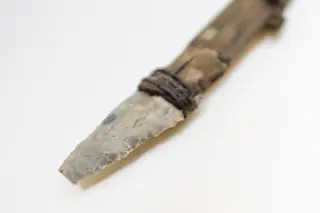Daggers like Ötzi’s may have had symbolic significance during the Copper Age. (Credit: South Tyrol Museum of Archaeology) Though he died 5300 years ago in the Alps near the Austrian-Italian border, the prehistoric man known as Ötzi the Iceman has had a remarkable afterlife in the sciences. His mummified body chiseled out of ice in 1991 has undergone extensive examination, revealing details about his life and times. The work has offered a glimpse into the everyday life of Alpine inhabitants in the late 4th millennium BC. A paper published Wednesday in PLOS One reveals the extent to which the Iceman maintained his tools and arrows, and adds to the research on the trade networks of the time.
Ötzi’s tools were stored in his belt pouch. Several of them were designed to cut plants and soft wood and had been re-sharpened multiple times, the paper says. Others were proto tools, the ...














